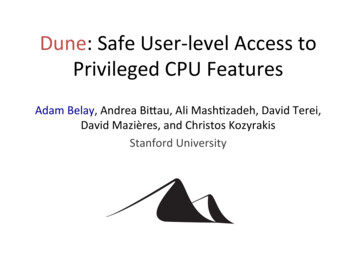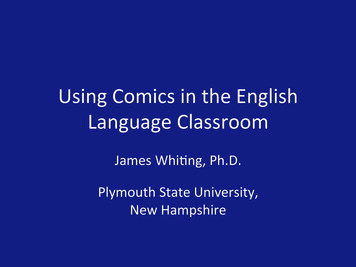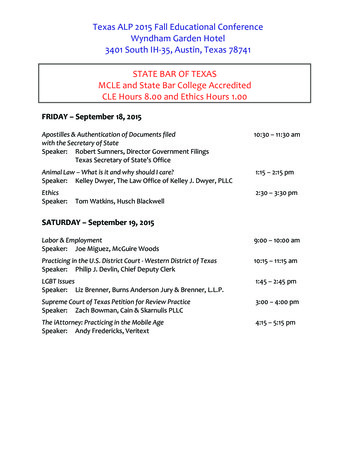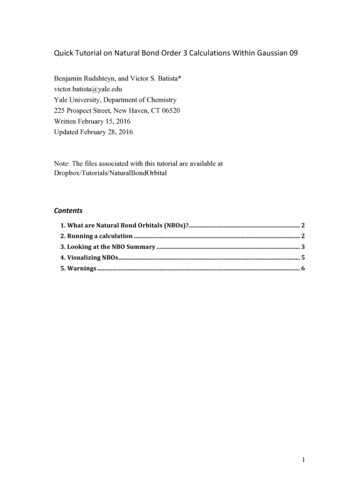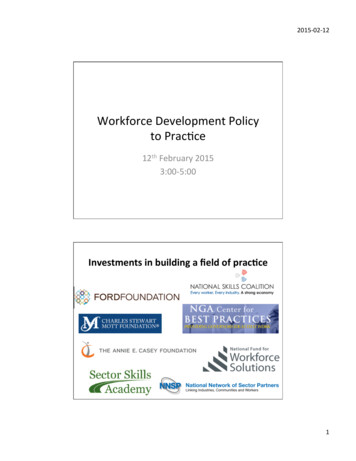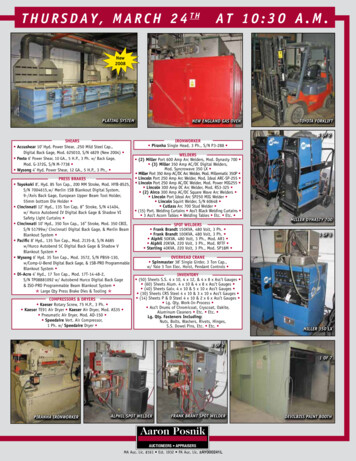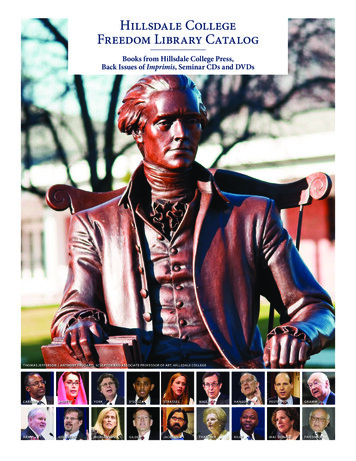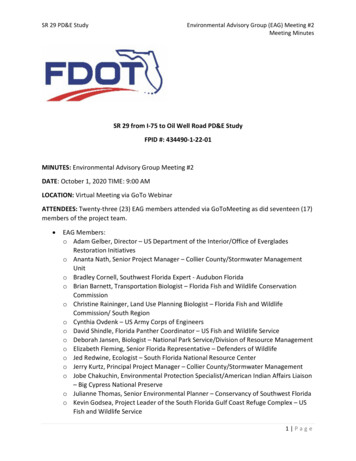
Transcription
SR 29 PD&E StudyEnvironmental Advisory Group (EAG) Meeting #2Meeting MinutesSR 29 from I‐75 to Oil Well Road PD&E StudyFPID #: 434490‐1‐22‐01MINUTES: Environmental Advisory Group Meeting #2DATE: October 1, 2020 TIME: 9:00 AMLOCATION: Virtual Meeting via GoTo WebinarATTENDEES: Twenty‐three (23) EAG members attended via GoToMeeting as did seventeen (17)members of the project team. EAG Members:o Adam Gelber, Director – US Department of the Interior/Office of EvergladesRestoration Initiativeso Ananta Nath, Senior Project Manager – Collier County/Stormwater ManagementUnito Bradley Cornell, Southwest Florida Expert ‐ Audubon Floridao Brian Barnett, Transportation Biologist – Florida Fish and Wildlife ConservationCommissiono Christine Raininger, Land Use Planning Biologist – Florida Fish and WildlifeCommission/ South Regiono Cynthia Ovdenk – US Army Corps of Engineerso David Shindle, Florida Panther Coordinator – US Fish and Wildlife Serviceo Deborah Jansen, Biologist – National Park Service/Division of Resource Managemento Elizabeth Fleming, Senior Florida Representative – Defenders of Wildlifeo Jed Redwine, Ecologist – South Florida National Resource Centero Jerry Kurtz, Principal Project Manager – Collier County/Stormwater Managemento Jobe Chakuchin, Environmental Protection Specialist/American Indian Affairs Liaison– Big Cypress National Preserveo Julianne Thomas, Senior Environmental Planner – Conservancy of Southwest Floridao Kevin Godsea, Project Leader of the South Florida Gulf Coast Refuge Complex – USFish and Wildlife Service1 Page
SR 29 PD&E StudyEnvironmental Advisory Group (EAG) Meeting #2Meeting Minuteso Mark Danaher, Supervisor of Wildlife Biologist ‐ US Fish and Wildlife Serviceo Melissa Roberts, Regulatory Service Center Administrator/Lower West Coast ServiceCentero Meredith Budd, Regional Policy Director – Florida Wildlife Federationo Robert V. Sobczak, Hydrologist – Big Cypress National Park Preserveo Robert Wiley, Principal Project Manager – Collier County/Stormwater Managemento Shannon Estenoz, Vice President of Policy and Public Affairs/Chief Operating Officer– The Everglades Foundationo Thomas Forsyth, Superintendent – Big Cypress National Preserveo Tom Trotta, Past President ‐ Friends of the Florida Panther Refugeo Tony Pernas, Resource Management Chief – Big Cypress National Preserve Project Team:o Jennifer Marshall, District Environmental Administrator – FDOT District 1o Kimberly Warren, FDOT Project Manager – RK&K (FDOT D1 consultant)o Gwen Pipkin, Environmental Manager – FDOT District 1o Patrick Bateman, Engineer – FDOT District 1o Jennifer Dorning, Senior Public Involvement Specialist – Atkins (FDOT D1 consultant)o Siobhan Gale, Transportation Planner – RK&K (FDOT D1 consultant)o Gabriela Garcia, Project Manager– Metric Engineeringo Robert Myers, Environmental Scientist ‐ Metric Engineeringo Alicia Gonzalez, Principal – Media Relations Group, LLCo Caitlin Hill, Environmental Scientist ‐ Metric Engineeringo Daniel Smith, Roadway Ecologist ‐ UCFo Derek d’Adesky – Metric Engineeringo Eunice Sanders, Assistant Community Outreach Specialist – Media Relations Group,LLCo Jorge Valens, Public Information Specialist – Media Relations Group, LLCo Mark Scott, Drainage – Metric Engineeringo Michael Holt, Drainage– Metric Engineeringo Paul Carballo, Project Engineer‐ Metric Engineering2 Page
SR 29 PD&E StudyEnvironmental Advisory Group (EAG) Meeting #2Meeting MinutesWELCOMEFDOT District One Environmental Administrator, Jennifer Marshall, welcomed all theattendees to the second official virtual EAG meeting, after which each attendee brieflyintroduced themselves and the organizations they represent.Jennifer explained that she will begin with a presentation which provides a briefoverview of the project status. At the end of the presentation, she will move on to afocused discussion on specific items that FDOT is requesting input on. The focusdiscussion items have been marked with a star on the presentation. Then the EAGmembers will have the opportunity for open discussion.SUMMARY OF PRESENTATIONI.Meeting Agenda (Slide 2)Jennifer Marshall introduced the presentation portion of the meeting by noting thatthe PDF of the presentation slides, and note slides, were distributed to all of the EAGmembers. The presentation will also be available online on the project website.Meeting minutes will also be available on the project website thirty (30) calendar daysfollowing the meeting.Jennifer discussed the purpose of the meeting, which was to review our preliminaryanalysis to date, project status and next steps. She explained that as we movedthrough the presentation, there will be stars in the areas that we wish to have focuseddiscussion. Jennifer stated that these are specific areas that she would like to havefeedback from the EAG members to help guide our analysis and considerations as wefurther develop the alternatives. She asked that the EAG members hold theircomments until the focused discussion portion of the presentation. It was noted thatif members of the public wished to speak, they would be provided an opportunityduring the during the open discussion following the EAG member discussion.Jennifer stated that we know that there are questions regarding how this project fitsin with M‐CORES. At this point we do not have this answer. M‐CORES could be apotential funding source in the future and the project team is working closely with theM‐CORES project team. The future of this PD&E study, whether it remains a stand‐alone project or is absorbed into the M‐CORES program, is unknown at this time.The presentation by Jennifer continued with a discussion of the following:II.EAG Goals and Previous EAG Coordination/Meeting (Slide 4)3 Page
SR 29 PD&E StudyEnvironmental Advisory Group (EAG) Meeting #2Meeting MinutesJennifer provided a brief description of the goals for the EAG and the role that EAGmembers have as part of the study, which is to share information and ideas that helpachieve the project’s purpose and need with the least overall harm to theenvironment, and to assist in the identification of environmental issues to beaddressed within the scope of this PD&E Study.Jennifer also provide a brief recap of previous EAG coordination during the first EAGMeeting held on May 9, 2019.Jennifer discussed the August 16, 2019 letter received from the National Parks Serviceand US Fish and Wildlife Service (USFWS) following the first EAG meeting.o Response is pendingo Included in this presentation, however, are points and recommendationsmade in the letter for discussion with the EAG.III.Purpose and Need (Slide 5)Jennifer stated that the project’s current purpose and need was summarized on theslide. She referenced the letter from the National Parks Service and USFWS, whichrecommended a broader Purpose and Need for the project. At this time, we arefocusing on the current Purpose and Need, but will update the EAG as changes occurthroughout the life of the project.IV.Existing State Road 29 (Slide 6)Jennifer discussed the current footprint of State Road 29 from Oil Well Road to I‐75.She pointed out that within the boundaries of the Florida Panther National WildlifeRefuge, USFWS currently leases the eastern 100 feet from the FDOT. The SR 29existing 180‐foot right‐of‐way includes that lease area that would be used for futureroadway improvements.V.Preliminary Typical Section Analysis (Slides 7 & 8)Jennifer mentioned the letter from the National Parks Service and USFWS requestedthe study provide “full and robust” alternatives for consideration. The study willcontinue to evaluate a four‐lane typical section as well as the recommendationsprovided in the letter, although we are in the very preliminary stages of the study.Additional coordination with stakeholders and partner agencies will continuethroughout the life of this project.4 Page
SR 29 PD&E StudyEnvironmental Advisory Group (EAG) Meeting #2Meeting MinutesJennifer briefly discussed the features of the four‐lane typical section as the basis foreach of the alternatives.VI.Concept Development (Slides 9 & 10)Jennifer then went through the widening and reconstruction alternatives, discussingspecific features of each of the options.VII.Constrained Areas (Slide 11)Jennifer discussed the areas that have been identified by the study as constrainedareas within the project limits. She also requested additional feedback during thefocused discussion on the recommendation in the joint letter from the NPS andUSFWS for a single bridge from Bear Island to Pistol Pond, and that a cost analysiswould be required. Jennifer also requested additional feedback on the request for asingle bridge at Henson Marsh.VIII.Preliminary Drainage Concepts (Slides 12‐14)Jennifer discussed components of each of the preliminary drainage approaches, threein total. Approach #1, Offsite Ponds with Canal Conveyance; Approach #2, OffsitePonds with Swale Conveyance; and Approach #3, Linear Swales. Jennifer mentionedthe request for new culverts as part of the joint letter, but we are not at that step inthe analysis yet. She noted that the project team will continue to review for futureanalysis. Jennifer requested feedback regarding the members’ drainage concernsduring focused discussion.IX.Preliminary Environmental Evaluation (Slides 15 & 16)Jennifer discussed areas identified in the preliminary environmental evaluation thatwe will be further analyzing and documenting as we move forward.o OFWo Federally protected specieso Wildlife crossingso Discuss more during focused discussion. Jennifer noted the NPS andUSFWS request for additional crossings and wildlife shelving in theirletter.o Socio‐Culturalo Continued coordination with Seminole and Miccosukee tribeso We do not anticipate impacts to historical and archeologicalresources as part of this project5 Page
SR 29 PD&E StudyEnvironmental Advisory Group (EAG) Meeting #2Meeting Minuteso Potential Section 4(f) – evaluating how the project affects publicrecreational and conservation lands The NPS and FWS made a recommendation to enhanceexisting and proposed public land access in their letter – stilltoo early in the study, but the project team is requestingfeedback during the focused discussion.o Physical Environmento Noiseo ContaminationX.Project StatusJennifer gave a brief update on the status of the project.o Future fundingo Cost increase for extended/new bridges and structureso Discussions ongoing with: Collier County MPO Project teams/representatives for regionalongoing/upcoming/future projectso Revenue shortfalls from COVID FDOT is evaluating priorities and SIS Plan M‐CORES is still a potential funding source, but this projectneeds to be able to be implemented independent of M‐CORES, if needed Schedule is being adjusted based upon the fact that funds arenot currently available for future phases and the need forconsistency with the MPO planning document Allows more opportunities for continued coordination withstakeholders and agency partners The project team will advise the EAG members by email of thenext steps as they are determined.FOCUSED DISCUSSIONJennifer asked that members of the EAG provide comments related to each topic asthey are called upon by agency. Jennifer also requested any additional comments beprovided 7 ‐14 days following the meeting in order to be included in the minutes.6 Page
SR 29 PD&E StudyEnvironmental Advisory Group (EAG) Meeting #2Meeting MinutesFOCUSED DISCUSSION ‐ WIDENING VS. RECONSTRUCTION ALTERNATIVES (Slide19):Brad Cornell, Audubon Florida – Brad mentioned the FDOT project to widen I‐75 inCharlotte County and the collaboration with DEP and Florida Forever Program to buyproperties to accommodate drainage and water quality treatment mitigation in aFlorida Forever project to restore the ranch. Brad believes this was a progressive ideafrom FDOT and a regionally aware strategy that should be considered as part of thisproject. Additionally, widening the drainage scope in each of the alternatives shouldbe considered.Jennifer provided additional clarification on M‐CORES comments stating that thelanguage in the statue for M‐CORES provides more latitude for conservation activities.Roadway projects like this one for State Road 29 may require additional collaboration.These are opportunities the project team will continue to look at.Bob Sobczak, Big Cypress National Preserve – Bob mentioned alternatives to includefuture conditions of the canal being filled in. Plans to fill in the canal in next 10 yearsare included in US Army Corps of Engineers and Collier County Watershed Plan. Thisstudy should include alternatives that are complimentary and compatible with thoseplans.Jennifer mentioned we could discuss this more during the drainage discussion, butthat the project has the flexibility to modify drainage.Bob asked if widening the roadway takes away more of the stormwater swale alongthe east side of the road.Jennifer responded that there are more opportunities to convey water within theright‐of‐way in swales if we widen the roadway. Widening and reconstruction comesdown to cost. It is more expensive to reconstruct the roadway vs. widening andconstructing new lanes; however, adding the recommended structures may be easierto accomplish in the reconstructing alternative vs. retrofitting later in the wideningalternative.Bob agreed it may be easier to accomplish in the reconstruction alternative.Jennifer mentioned this is all part of the ongoing analysis.7 Page
SR 29 PD&E StudyEnvironmental Advisory Group (EAG) Meeting #2Meeting MinutesTony Pernas, Big Cypress National Preserve – Tony stated that at the last meeting,Big Cypress Preserve offered FDOT a lifetime easement for the canal/water qualityaspects and for integrating sidewalk or trail features. This appears to have been leftout of both alternatives.Jennifer indicated that she would follow‐up on that.Jerry Kurtz, Collier County Stormwater – Jerry mentioned the thought of filling in thecanal used to horrify him as Immokalee could potentially flood. Over time, andworking with Bob, I understand filling‐in the canal could be happening or at least apossibility. We need to do something with the water which needs to come downthrough a major drainage outlet. The water will need to go somewhere if the canal isfilled in. As a general comment, it looks as though the project is being constrainedalong the east side of the road because of the canal. Use that to integrate into theproject for water divergence. Embrace it and look at moving water east/west insteadof north/south. There are issues currently, including maintenance of the canal.Robert Wiley, Collier County Stormwater – The concept of using the canal for regionalflow includes conveyance of water coming directly from State Road 29, an issue thatneeds to be resolved. We are not supportive of using the canal to convey water andthen putting the entire canal slope into some type of treatment pond system becauseyou have so much pollution going on that it may become ineffective. Moving water tothe west should be considered. Collier County currently has drainage easements fromSunniland up to Immokalee, which we did not have at the time we first begandiscussing this project. However, we do not have easements on federal lands.Reconstruction may be better than widening because shifting the road to the eastmakes it even more difficult to get water quality out of the existing swale. We wouldlike a system that is also maintainable.Julianne Thomas, Conservancy of Southwest Florida – It is difficult at this time todiscuss widening vs. reconstruction since everything is interconnected. Preferencegiven to the alternative that provides better hydrology and wildlife crossings but beingpresented alternatives in this format is difficult. I do appreciate other’s comments thatFDOT be creative and look broadly at the project for hydrology and to move wildlifeeffectively.Jennifer responded that it is not necessary to have a preference at this time and thatFDOT is taking a holistic approach to the project. The meeting format is simply to makeit easier for the minutes to be prepared, but please feel free to provide commentsthroughout the discussion.8 Page
SR 29 PD&E StudyEnvironmental Advisory Group (EAG) Meeting #2Meeting MinutesElizabeth Fleming, Defenders of Wildlife – Echo comments offered by theConservancy and, in addition, since this is the EAG, we should have an overallapproach or criteria that however this road is configured, it does the least amount ofdamage to the environment. It should also undo previous damage created prior tothere being this much information about hydrology and wildlife connectivity. Pleasekeep that in mind for overall broad planning and take notes from the EAG as wecontinue these discussions.Brain Barnett, Florida Fish and Wildlife Conservation Commission – If we are able toaccommodate longer bridges/structures as part of this project, would eitheralternative be better suited for that?Jennifer explained that one alternative is not necessarily better than the other. Asmentioned earlier, it may be simpler if we reconstruct the road instead of retrofittingstructures in the widening alternative. Either alternative can accommodatebridges/structures though.Meredith Budd, Florida Wildlife Federation – Echo comments previously made. It isdifficult to discuss alternatives until there is more information on hydrology andwhere the water will go. Taking the footprint of the roadway into consideration, willthe reconstruction alternative leave a smaller footprint than the wideningalternative? We need to look at the best ways to enhance hydrology and wildlifehabitat connectivity. At this time, I cannot say the Federation prefers one alternativeover the other. There are components still to be addressed: are we enhancinghydrology in the region? Reconnecting wildlife habitat? Minimizing and avoidingimpacts to the environment?Jennifer expressed she does not want any agency to feel like we are asking for anofficial position at this time. Feedback is simply for discussion and record keeping. Toaddress the comments made concerning the footprint, there are no substantialchanges in the roadway footprint, more so how to incorporate changes within theright‐of‐way.Kevin Godsea, US Fish and Wildlife Service, Project Leader of the South Florida GulfCoast Refuge Complex – No preference on alternatives yet as more information isneeded. For the reconstruction alternative, where are the swales and canal drainingto? Is water being re‐directed away from the refuge? Removing the shoulder of theroadway removes recreational access for fisherman who use the canal to fish. Pleasetake that into consideration for the reconstruction alternative.9 Page
SR 29 PD&E StudyEnvironmental Advisory Group (EAG) Meeting #2Meeting MinutesJennifer clarified that each of the alternatives includes minimum five (5) footshoulders. Some areas may be wider to accommodate guardrail, etc. Kevin also mentioned the need for wider clear‐out zones for the Crested Caracarawhich is advantageous to their foraging efforts.Jed Redwine, South Florida National Resource Center – Echo and support commentsmade by Big Cypress National Preserve. May need subtle combinations of bothalternatives. Alternatives that maintain run‐off within swales are desirable to reducesediment effects. Prefer to keep run‐off as isolated from the canal/watershed as muchas possible. To reduce regional flood concerns, Big Cypress and others have suggestedbridges and improvements at Okaloacoochee Slough to positively impact watershedby allowing water to flow, reduce peak flooding events. Appears to be positives andnegatives to both alternatives, but reconstruction may offer opportunities to correctmistakes made in the past because we had less knowledge and information at thetime. Hard to say one alternative is better than the other until we are closer to atentatively selected alternative. Real and practical alternatives with concretecharacteristics that can be measured against the project objectives.Dave Shindle, US Fish and Wildlife Service South Florida Ecological Services Field,Florida Panther Coordinator – Attending this meeting on behalf of John Wrublik. Echocomments that we hold on suggesting a preference until more information/details areavailable. Initial preference would be reconstruction, but that depends on where off‐site ponds would be located. Expressed concerns that a five (5) foot shoulder will notaccommodate ongoing recreational activities. We also need a better understandingof how this project could be associated/impacted by M‐CORES.Jennifer reiterated that we are still in the very preliminary stages of the project andthat more detailed information will of course be available as we progress in thisproject. Simply seeking feedback at this time, and to see whether any of the agenciesnote flaws in the preliminary alternatives or potential flaws we can hopefully addressnow.Melissa Roberts, South Florida Water Management District – From a regulatorystandpoint, the district does not have a preference at this time. We will continue toreview/permit preferred alternative once FDOT is ready to move forward.Shannon Estenoz, The Everglades Foundation – Can you elaborate on what youmeant by budget shortfalls earlier in the presentation?10 P a g e
SR 29 PD&E StudyEnvironmental Advisory Group (EAG) Meeting #2Meeting MinutesJennifer clarified that the State of Florida relies heavily on gas tax for revenue. DuringCOVID, the reduced driving and tourism impacted revenue availability. FDOT will alignprojects, including this study, for when future funding could be available. FDOT willpace the project schedule as needed.Shannon followed up asking if FDOT was still operating as this project paying for itselfoutside of potential M‐CORES funding.Jennifer confirmed and further noted that we do not yet know how the project couldpotentially tie‐in with M‐CORES. The project team continues discussions with the M‐CORES project team, but is also moving forward with the PD&E.Cynthia Ovdenk, US Army Corps of Engineers – Prefers to reserve comments for whenshe has had more time to review information and presentation. As she is new to thisproject, Cynthia also wanted to know if the previous EAG member had comments in2019. Agrees avoidance and minimization will be key.Jennifer offered to follow‐up with Cynthia to help her get up to speed on this projectand provide meeting minutes from the first EAG meeting held in 2019.John Wrublik, US Fish and Wildlife Service (provided after the meeting) – Stated thathe does not have conflicts with the alternatives. Emphasized minimization of impactsby staying within the existing right‐of‐way as much as possible. Within the existingright‐of‐way, minimize the footprint of the typical section. Cited the use of jerseybarriers within the median on projects in Dade and Monroe Counties that reduced theoverall typical section width by minimizing the median and is a potential safetyimprovement.FOCUSED DISCUSSION – CONSTRAINED AREAS (Slide 20)Jennifer indicated bridge and wildlife crossing comments can also be included in thistopic.Brad Cornell, Audubon Florida – Nothing more to add in addition to what has alreadybeen addressed in the letter from the National Parks Service and USFWS.Bob Sobczak, Big Cypress National Preserve – Supports the two‐mile long bridge overOkaloacoochee Slough recommendation from the National Parks Service and USFWSletter. Ensure road widening is compatible with future fixes. The bridge will be anessential component of that.11 P a g e
SR 29 PD&E StudyEnvironmental Advisory Group (EAG) Meeting #2Meeting MinutesJerry Kurtz, Collier County Stormwater – The movement of water inconstrained/unconstrained areas is important. If the canal is filled in, determine flowways to solve ongoing issues. Use the landscape to manage the water, if possible.Robert Wiley, Collier County Stormwater – Echo comments made by Jerry. A seriesof bridges/wildlife crossings or a series of box culverts would help pass the flow.Julianne Thomas, Conservancy of Southwest Florida – The Conservancy supports theletter and recommendations from the National Parks Service and USFWS. Noadditional comments at this time.Elizabeth Fleming, Defenders of Wildlife – Mentioned previous I‐75 project thatincluded improvements to State Road 29 and the subsequent wildlife crossings thatfollowed as part of that project. Recalls recommendation at the time from FFWCC thatwider shoulders would be more beneficial specifically for the Florida Pantherpopulation. Does not want this project and roadway improvements to undermineprevious recommendations.Jennifer asked for clarification on the five (5) foot shoulders, asking if Elizabeththought the shoulders should be wider than five (5) feet or just to ensure there areshoulders included?Elizabeth responded saying she did not know what the correct amount of space wouldbe and deferred to other agency experts/panther experts. Elizabeth does not want toreduce the effectiveness of what is already there, though that is not always aseffective as it should be.Brain Barnett, Florida Fish and Wildlife Conservation Commission – No additionalcomments at this time.Meredith Budd, Florida Wildlife Federation – No additional comments at this time.Appreciates agency input and considerations being suggested.Kevin Godsea, US Fish and Wildlife Service, Project Leader of the South Florida GulfCoast Refuge Complex – Kevin stated he did not want the project to impact futurehydrology fixes. Hydrology has been a huge issue to the refuge in terms of bridges inthe Okaloacoochee Slough area. Maximizing wildlife crossings and hydrologic flowreduces the need for fencing in those areas. More bridges less fencing and lessfencing better aesthetics for travelers along the road as well. Future planning isunderway for additional public access to the refuge. These plans include maps ofpotential access points. This should be available for public review in February/March12 P a g e
SR 29 PD&E StudyEnvironmental Advisory Group (EAG) Meeting #2Meeting Minutes2021. This project has the potential to also impact Pistol Pond access, as well asseveral access points along State Road 29.Jennifer stated that the project team has a copy of the map, it was included in theletter from the National Parks Service and USFWS, but it would be helpful to haveupdated copies as they become available.Mark Danaher, US Fish and Wildlife Service – Cannot stress enough how importantthe bridges are. Historically, water would have flowed through OkaloacoocheeSlough, across what is now Big Cypress and into what is now the Panther Refuge toform the headwaters of the Fakahatchee Strand, likely the most biodiverse forest andwetland we have in the entire State of Florida, it supports the highest amount oforchids, including Ghost Orchids. The strand flows approximately 35 kilometersthrough Fakahatchee Strand State Preserve and State Park, discharging into 10,000islands. Currently, State Road 29 and Barron River Canal jaunt and divert a lot of waterthat would historically flow into Fakahatchee Strand, instead points discharges intoEverglades City. He indicated that he cannot stress the importance of having thisinfrastructure in place because if we don’t do it now, it is highly unlikely it will happenin the future. Existing plans in the Southwest Florida Comprehensive Watershed Planwhich state and federal agencies have spent millions of dollars developing. Twoprojects currently in the plan: State Road 29 and Barron River Canal flow‐way and theOkaloacoochee Slough Functional Group that already addresses a lot of the issues andconcerns we share with this State Road 29 widening project. Plans are already in placeso, hopefully, these bridges will allow us to get to a point of doing meaningfulhydrologic restoration. But if we don’t have the bridges in place the likelihood of thathappening is probably non‐existent once new widening occurs. To highlight theimportance of these bridges, in addition to minimizing the need for fencing, there hasbeen previous roadkill research conducted on State Road 29 in 2017 by University ofKent Master Student, Mark Spicer. Mark drove State Road 29 corridor from LaBelle toOchopee daily recording roadkill. In particular, the East Henson Marsh andOkaloacoochee Slough intersection with State Road 29 was one of the highest roadkillhotspots that he identified. The refuge did intermittent roadkill research, butultimately stopped because it became unsafe due to traffic and highway speeds onState Road 29. The recommended bridges would serve multiple objectives.Jennifer stated that the project team is noticing a theme between comments. Thereis a lot of ongoing work in this area to address hydrology concerns. What we arehearing from the EAG is that the bridges, in particular, will be a great step forward forthis project in addressing that and for setting up for future improvements that maynot come directly out of this project.13 P a g e
SR 29 PD&E StudyEnvironmental Advisory Group (EAG) Meeting #2Meeting MinutesJed Redwine, South Florida National Resource Center – I‐75 is a good example as itis hydrologically invisible in our regional models and that is where we would like forthis road to be as well, hydrologically invisible and also in regards to animals beingable to cross. The road will never be invisible in terms of sound effects, asimprovements which increase traffic and sound, but reflecting on and mitigating thatis a desirable feature. Sound does have an impact on wildlife, hard to perceive anddocument sometimes. I am in agreement with the general theme being laid out andcontinuing to evaluate precise options that emerge from these discussions. Thisroadway is a very important piece in the regional puzzle and needs to be designed inharmony with that regional puzzle.Melissa Roberts, South Florida Water Management District – No comm
SR 29 PD&E Study Environmental Advisory Group (EAG) Meeting #2 Meeting Minutes 1 Page SR 29 from I‐75 to Oil Well Road PD&E Study FPID #: 434490‐1‐22‐01 MINUTES: Environmental Advisory Group Meeting #2 DATE: October 1, 2020 TIME: 9:00 AM LOCATION: Virtual Meeting via GoTo Webinar .



